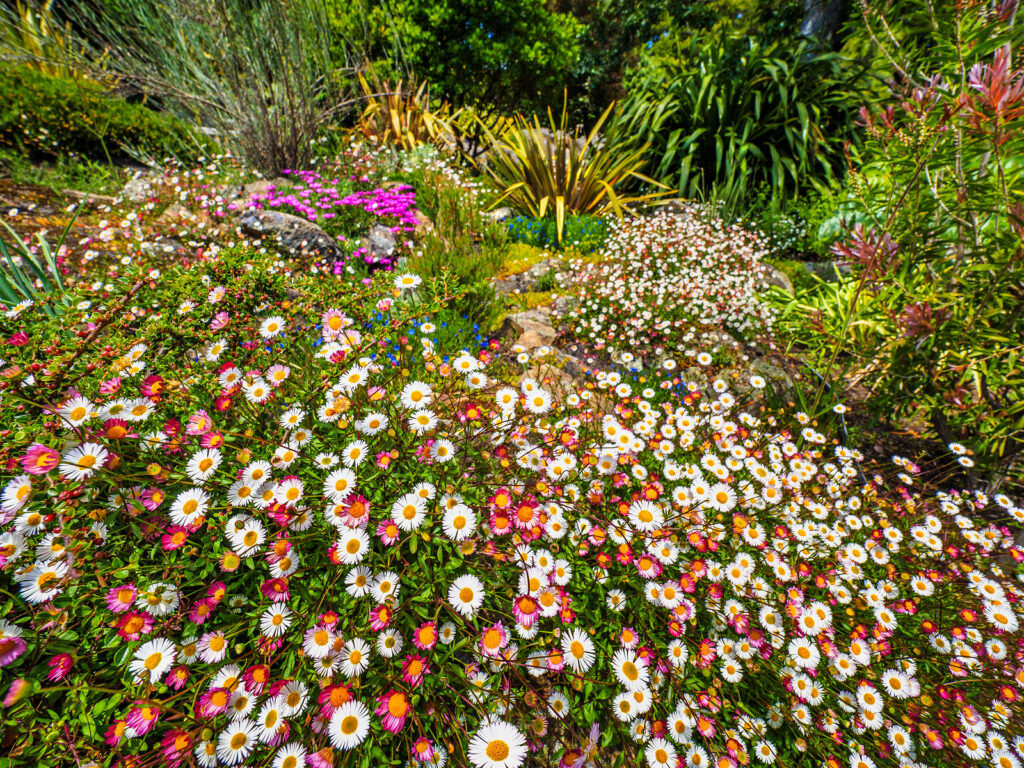Erigeron–commonly called fleabane–is a low-growing, somewhat bushy North American native that bears flowers that looks like small asters. Erigeron is easy to grow in nearly all well-drained soils.
Erigeron produces a rosette of simple, lance- to spoon-shaped or oval leaves. The daisy-like flowers are single or double and consist of many narrow ray florets (petals) commonly white but also yellow, purple, pink, or violet blue. The ray florets surround dense, usually yellow buttonlike centers.
Grow Erigeron in a mixed border or in a rock garden. Erigeron can also line walks or drives. Erigeron readily self-sows so thin and contain plants once or twice a year.
There are about 200 species in the Erigeron genus.

Get to know Erigeron
- Plant type: Perennial, biennial, or annual
- Growing zones and range: Zones 5 to 8
- Hardiness: Hardy to -35°F (-37°C); hardy to Zone 5
- Height and width: 24 inches tall by 24 inches wide (51 cm x 51 cm)
- Foliage: Rosette of simple, lance- to spoon-shaped or oval leaves.
- Flowers: 2-inch (5cm), aster-like, single or semi-double flowers; threadlike rays in two or more rows
- Flower colors: Shades of pink, purple, white, yellow, orange, or lavender, with yellow centers.
- Bloom time: Summer
- Uses: Some species are good for a mixed border; for a rock garden.
- Garden companions: Sea hollies (Eryngium), wormwoods (Artemisia).
- Common name: Fleabane
- Botanical name: Erigeron
- Family name: Asteraceae
- Origin: North America
Where to plant Erigeron
- Plant Erigeron in full sun with afternoon shade especially in hot summer regions.
- Plant Erigeron in nearly any well-drained soil; humus-rich soil is best; alpine species need excellent drainage.
- Plant in drifts of three or more for season-long color.
Erigeron uses and companions
- Use Erigeron in naturalistic or cottage gardens.
- Use Erigeron as border or bed edging. Allow Erigeron to spill over the top of a wall.
- Good garden companions for Erigeron include Gypsophila paniculata, Helenium autumnale, Monarda, Oenothera.

When to plant Erigeron
- Plant container-grown Erigeron in spring or autumn; plants may not look good through the winter but will come back in spring.
Planting and spacing Erigeron
- Plant Erigeron 12 to 18 inches (30-46cm) apart.
- Sow seeds in containers in spring for transplanting out in autumn.
How to water and feed Erigeron
- Keep the soil evenly moist for best growth and flowering. Erigeron can survive drought but will become thin and leaves will turn red-brown.
- Fertilize Erigeron in spring with an all-purpose organic fertilizer.

How to care for Erigeron
- Cut back Erigeron after flowering to reduce weediness and rejuvenate foliage.
- Taller varieties of Erigeron may require staking.
Erigeron pests and diseases
- Erigeron can develop leal spots, mildew, rust, and yellows.
- Erigeron can be attacked by aphids.
Erigeron propagation
- Take basal cuttings and divide Erigeron in spring.
- Divide Erigeron every three years.
- Erigeron seeds germinate in 14 to 30 days at 53° – 55°F (11° – 13° C).

Erigeron varieties to grow
- E. glaucus, Beach aster, a perennial, bears reddish-purple blooms; salt-tolerant (native to West Coast seaside); grows to 1 foot (.3m) tall; cultivar ‘Albus’ has white flowers; ‘Elstead Pink’ has lavender-pink flowers.
- E. karvinskianus, Mexican Daisy, Santa Barbara Daisy, is a dwarf trailing plant, that bears masses of white to pink flowers all summer; native to Mexico; it is hardy in Zones 8 to 9 but reseeds freely in colder zones; grows 10 to 20 inches (25-50cm) tall; leaves to 1 inch (2.5cm) long, often toothed at tips; dainty flower heads .75 inch (2cm) across within numerous white or pinkish rays; use as ground cover in garden beds or large containers, in rock gardens, in hanging baskets, on dry walls; naturalizes easily but can be invasive unless controlled. Cultivar ‘Moerheimi’ is somewhat more compact than species, with lavender tinted flowers.
- E. pulhellus, Robin’s plantain, has pink, blue, or white flowers; biennial or short-lived perennial; grows 2 to 2.5 feet (.6-.75m) tall.
- E. speciosus, Oregon fleabane or daisy fleabane is the most common fleabane; has lavender-blue flowers; perennial; grows to 2 feet (.6m) tall; flower heads 1 to 1.5 inches (2.5-4cm) across, with dark violet or lavender rays. ‘Azure fairy’ is 30 inches (76cm) tall with semi-double lavender-blue flowers. (Some nurseries sell this as ‘Azure Beauty’, but that is a different plant); native to the Pacific Northwest Coast; erect, leafy stemmed. Hybrids are available; they have larger flower heads and come in white and pink as well as blue shades. Among these is azure blue ‘Blue Beauty’, violet-blue ‘Darkest of All’, light violet ‘Strahlenmeer’, ‘Pink Jewel’ in various pink shades, carmine-pink, ‘Foerster’s Leibling’ (Foerster’s Darling), bright reddish-pink, semi-double blossoms. 2 feet (.6m) tall, and white ‘Schneewittchen’ (‘Snow White’), ‘Rosa Triumph’ is 24 inches (60cm) tall, with large, clear pink, double flowers; ‘Dimity’ is a dwarf, 12 inches (30cm) tall, with pink blooms.















